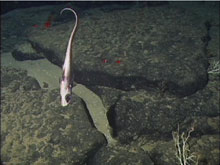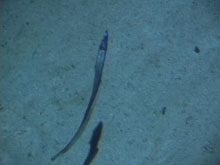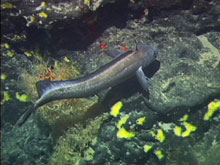A gadid forages for prey among basalt and the invertebrates attached to it. Click image for larger view.
Fishes in Seamount Landscapes
Peter Auster
Fish Biologist
National Undersea Research Center
University of Connecticut
Why study fish? There are many reasons. First, fish are the most diverse form of vertebrates (animals with backbones) on Earth. There are over 24,000 fish species, living in habitats that range from high altitude lakes to the deepest parts of the oceans. Over 590 species live in the deep-sea waters of the northwest Atlantic Ocean, right off the continental shelf of the northeastern U.S. Each day, every individual fish balances two major activities: finding prey and avoiding becoming prey. Deep-sea fishes have evolved an extraordinary range of modes for propulsion (swimming) and behaviors to search for and capture prey (feeding). These behaviors are constrained by, or a function of, the underwater landscape—a mosaic of places that support predation and provide shelter from predators.
We study fish in the deep ocean in the same way wildlife biologists study animals on land: we look at how individuals interact with the landscape in which they live. While is it relatively easy to study fishes associated with coral reefs (using scuba diving techniques to work in the fishes' environment), we require more complex technologies to access the fish living in seamount habitats. This year, on Mountains in the Sea 2004, Team Fish (Peter Auster, Jon Moore, Kari Hienonen) will use a remotely operated vehicle (ROV) to census and view fishes at depths of approximately 1,000-2,000 m. This census will include collecting data on species richness (the number of species present), their abundance, and their behavior patterns—specifically, habitat selection and foraging behavior.

A grenadier exhibits a head-down foraging posture, while drifting over the seamount landscape. Click image for larger view.
We will plan our dives using multibeam sonar maps to give us a perspective of the large-scale geological landscape of the seamount. These maps function much like aerial pictures or satellite images do for mountains on land. The water-column characteristics are also important components of the seamount landscape. Water flows over and around seamounts, bringing large zooplankton and fishes from the pelagic (open sea) realm. This connects mid-water environments that stretch across ocean basins with the seamounts. The speed and direction of currents produce different “flow” environments around seamounts to which fish may respond. Finally, the underwater landscape includes the structure-forming organisms (e.g., deep-sea corals) that live there. Corals, sponges, and other epifauna (animals that live on the sea bottom) form structures on the sea floor, much like bushes and trees do in a forest. Fish use these structures as shelter from predators and currents as well as places to forage on zooplankton and fishes.

A halosaur, in a head-up posture, searches for small crustaceans in the near-bottom water column. Click image for larger view.
The Mountains in the Sea 2003 expedition gave us a tantalizing glimpse of the diversity of fishes living on seamounts. Our six days of long dives indicated that we need to spend more effort to get a good picture of the fish community here. (Even our last dive produced a species new to the expedition; and we observed another species that may be a new record in the northwest Atlantic.) Our knowledge of deep-sea fishes in this region, gained mostly from dragging nets through the ocean, is incomplete. Dives this year should reveal even greater levels of species richness; and quantitative analyses should allow us to better predict the species richness of seamount fish communities.
Last year, we also observed that seamount fishes exhibit a range of behaviors for finding prey. These foraging behaviors included active searching along the sea floor; station-keeping at particular habitats to ambush drifting prey; and drifting in the water column in a head-up or head-down mode to ambush swimming or drifting prey. This year, we will conduct a “behavioral census” of fishes, based on last year's observations. These data will allow us to produce a refined picture of how seamount fishes divide the landscape, based on how they forage for prey.






















